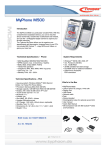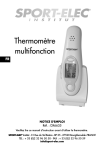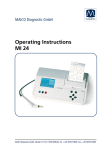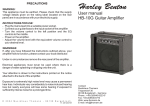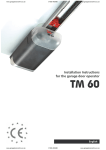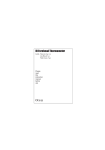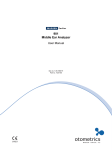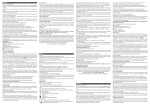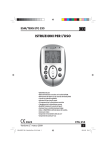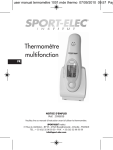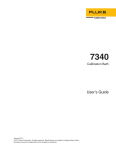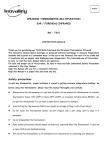Download to view the user manual for this device.
Transcript
FOREHEAD- AND-EAR THERMOMETER DX 6635 GB USER MANUAL • Precise measurement of body temperature in the ear and on forehead • Audio output of readings in German and English • Integrated light for nighttime usage • Digital display with blue back lighting • Additional function: Display shows time and room temperature (in standby mode) • Date, month and year display • Previous body temperature measurements saved • Practical stand for storage and safekeeping • Includes 2 x 1.5 V AAA batteries • With user manual 0123 Version 4, March 2009 2634-09DST_M_GB_GebrAnw_Stirn_Ohrthermo_2.indd 1 DX6635 1 27.04.09 09:11 GB TABLE OF CONTENTS 1.0 2.0 3.0 3.1 3.2 3.3 3.4 3.5 3.6 3.7 3.8 3.9 4.0 4.1 4.2 4.3 4.4 4.5 5.0 6.0 7.0 8.0 9.0 10.0 11.0 12.0 13.0 14.0 15.0 16.0 17.0 18.0 What the symbols mean..............................................................3 Usage and function of the forehead-and-ear thermometer...3 Safety Information........................................................................4 General Safety Information........................................................4 The uses and environs for which the forehead-and-ear thermometer is suitable..............................................................5 The uses and environs for which the forehead-and-ear thermometer is not suitable.......................................................5 The types of measurement for which the forehead-and -ear thermometer is suitable......................................................5 The types of measurement for which the forehead-and -ear thermometer is not suitable..............................................6 Usage by children and young persons.....................................6 Storage/maintenance of the instrument...............................6 Cleaning and care of the instrumenta.....................................7 Disposal of the instrument.........................................................7 Questions regarding aural (ear) temperature.......................8 What is aural temperature?........................................................8 How is aural temperature measured correctly?...................8 Why is the ear the best place to measure body temperature? .................................................................................8 The important concept of estimating body temperature.8 Differing body temperatures at differing temperature reading points.................................................................................9 Product contents and description of instrument parts... 10 LCD display indication............................................................... 11 Basic functions............................................................................. 12 Time mode.................................................................................... 13 Memory mode - recall of previous readings....................... 14 Set-up mode................................................................................. 15 Measuring temperature in the ear......................................... 16 Measuring temperature on the forehead............................ 16 Changing the battery................................................................. 17 Technical malfunctions............................................................. 18 Disposal of the batteries........................................................... 19 Disposal of the instrument...................................................... 19 Technical data and specifications.......................................... 20 Warranty........................................................................................ 27 2 2634-09DST_M_GB_GebrAnw_Stirn_Ohrthermo_2.indd 2 27.04.09 09:11 SYMBOLS AND FUNCTIONS GB 1.0 What the symbols mean The safety symbols shown in this manual are indications for the proper usage of the instrument and for the protection of your safety. The symbols stand for the following contents: Always read and respect the user manual. Caution/Risk: If used improperly, there is a risk of serious injury/damage. These directions must absolutely be adhered to. Device with application part type B Protection against electric shock through standard observance of the leakage current. 2.0 Application and function of the thermometer The DX 6635 is an infrared thermometer allowing easy and uncomplicated precise measuring of the body temperature. With the two measuring options for the measuring tip, you can measure the temperature on the forehead or in the ear. An acoustic signal indicates the end of body temperature measuring. You can read the measured body temperature on the display. The last 20 measurements are saved together with date and time. This allows you to read the last 20 measuring values prior to measuring again. 2634-09DST_M_GB_GebrAnw_Stirn_Ohrthermo_2.indd 3 3 27.04.09 09:11 GB SAFETY INFORMATION 3.0 Safety Information 3.1 General Safety Information 3.1.1 The forehead and ear thermometer DX 6635 is a sensitive medical products. It may not be subjected to shocks, blows or falls as these may cause a defect or destroy the product altogether. If such interference occurs, the measuring results may be faulty. If this is the case, contact our service center. (See page 27) 3.1.2 In the event of a defect, you must not attempt to repair, use, or modify (alter) the instrument yourself. 3.1.3 If irregularities should arise during usage of the foreheadand-ear thermometer, stop using immediately, and consult your doctor. 3.1.4 Do not perform any other activity during the measurement process. 3.1.5 If you should have any sort of doubt regarding the usage of the forehead-and-ear thermometer, you should first consult your doctor. 3.1.6 Keep and store these instructions for use in case of future query, and hand them over with the instrument, should you pass it on to a third party. Make the manual accessible for third parties, as it is a constituent part of the instrument as a whole. 3.1.7 Abusive and/or not application-oriented use of the instrument must be avoided. 3.1.8 No other accessory from another instrument may be used. 3.1.9 Caution: It is dangerous for the user to make a selfdiagnosis or to carry out any self-treatment based on the reading results from this instrument. A doctor‘s directions and recommendations are to be followed. Self-diagnosis can lead to a worsening of an illness or complaint. 3.1.10Do not take readings in the ear if you are suffering from an illness in or related to the ear, or if there is water in the ear (from showering, swimming...) 4 2634-09DST_M_GB_GebrAnw_Stirn_Ohrthermo_2.indd 4 27.04.09 09:11 SAFETY INFORMATION GB 3.2 The uses and environs for which the foreheadand-ear thermometer is suitable 3.2.1 Only use the forehead-and-ear thermometer for the designated intended purpose - the measuring of human body temperature. 3.3 The uses and environs for which the forehead-andear thermometer is not suitable 3.3.1 This instrument is not suitable or appropriate for medical or commercial use. It is intended for household/domestic use. 3.4 The types of measurement for which the forehead-and-ear thermometer is suitable 3.4.1 The forehead-and-ear thermometer DX 6635 is only suitable for taking body temperature measurements on the forehead or in the ear. 3.4.2 In the event of temperature differences between the storage location of the instrument and the room in which the measurement is to be taken, you must leave the thermometer to let it acclimatise to the room temperature for around 30 minutes. If you neglect to do this, inaccuracies in the readings taken can arise. 3.4.3 The body temperature can differ between right and left ear, and you should therefore always use the same ear when taking a temperature reading. 3.4.4 Before taking each reading, make sure that the ear canal is clean, because otherwise an inaccurate reading will arise. 3.4.5 Given that body temperature rises rapidly due to physical activity, and due to bathing/showering, you should always take readings during a quiet rest period. 2634-09DST_M_GB_GebrAnw_Stirn_Ohrthermo_2.indd 5 5 27.04.09 09:11 GB SAFETY INFORMATION 3.5 The types of measurement for which the forehead-and-ear thermometer is not suitable 3.5.1 The forehead-and-ear thermometer DX 6635 is not suitable for the following types of measurement: - Axillary measurements (under the arm) - Oral measurements (in the mouth) - Rectal measurement (in the anus) 3.6 Usage by children and young persons 3.6.1 Keep the forehead-and-ear thermometer out of reach of children. Children can hurt themselves by using the forehead-and-ear thermometer. Children can swallow small parts and this can lead to asphyxiation. Children can cause themselves injury by using the forehead-andear thermometer. 3.7 Storage/maintenance of the instrument 3.7.1 The instrument is maintenance-free. 3.7.2 If the device is not used for longer periods of time, remove the inserted batteries and observe the temperature and air humidity values listed on page 21. Exceeding or undercutting these values may impair measuring accuracy. 3.7.3 Do not disassemble or repair the instrument yourself as this can lead to technical malfunctions or injuries. The forehead-and-ear thermometer is calibrated at manufacture. 3.7.4 If the instrument is used according to the instructions for use, no new calibration is necessary. 6 2634-09DST_M_GB_GebrAnw_Stirn_Ohrthermo_2.indd 6 27.04.09 09:11 SAFETY INFORMATION GB 3.8 Cleaning and care of the instrument 3.8.1 The forehead-and-ear thermometer will not tolerate humidity/damp, vibration or being struck. Do not hold the forehead-and-ear thermometer under running water; do not immerse it in water or other fluids. 3.8.2 The forehead-and-ear thermometer is sensitive to heat, and must not be exposed to direct sunlight. Do not place the forehead-and-ear thermometer on any hot surfaces. 3.8.3 Clean the forehead-and-ear thermometer with a soft, slightly damp cloth. In the event of more serious dirt, a mild detergent may be used. 3.8.4 Carefully clean the measuring probe with a cotton swab. Do not touch or blow on the measuring sensor. A contaminated infrared sensor leads to inaccurate measuring results. Please use a standard disinfectant for plastic surfaces. 3.8.5 The instrument must not be turned on during cleaning and care. 3.8.6 Clean the measuring point before and after each body temperature reading with a commercially available disinfectant for plastic surfaces, in order avoid infection from pathogens. 3.9 Disposal of the instrument 3.9.1 If the forehead-and-ear thermometer should at some point be recycled, the disposal of it for this should be carried out in accordance with the legal requirements. You should ask your municipal authorities or waste management services provider. 2634-09DST_M_GB_GebrAnw_Stirn_Ohrthermo_2.indd 7 7 27.04.09 09:11 GB QUESTIONS REGARDING Body TEMPERATURE 4.0 Questions regarding aural (ear) temperature 4.1 What is aural temperature? The body temperature relates to the internal temperature of the body (core temperature). Because of this, the inner ear area can accurately reflect fluctuations in body temperature. 4.2 How is aural temperature measured correctly? Infants under one year old: Gently pull the ear diagonally backwards, in order to align the ear canal straight, and insert the measuring probe. Children aged over one year and adults: Pull the ear gently backwards, and insert the measuring probe along the ear canal. Pay attention that the measuring sensor points at the eardrum. 4.3 Why is the ear the best place to measure body temperature? If body temperature rises or falls, the body regulates its temperature beginning with the brain. The ear is the only place on the body near the brain which can be used to measure body temperature. 4.4 The important concept for estimating body temperature. The normal value for body temperature is a range, and not one fixed value. Each individual has his or her own personal range of body temperature. Body temperature varies with age, sex, time, activity and mood. People of differing ages will have different body temperatures; and even from one time of the day to another, an individual’s body temperature can vary. For example, the body temperature of children is 0.5°C higher than that of adults; most people have a lower body temperature when sleeping, and then the body temperature will go up over the course of the day. Different parts of the body give different readings for 8 2634-09DST_M_GB_GebrAnw_Stirn_Ohrthermo_2.indd 8 27.04.09 09:11 QUESTIONS REGARDING Body TEMPERATURE GB body temperature measurements. Normally, rectally measured body temperatures will be 0.3°C higher than body temperatures taken orally, while this area in turn gives values 0.3°C higher than those taken from readings in the armpit. In order to establish your personal normal body temperature, and obtain readings for family members, too, you can take body temperature readings at differing times of the day, over the course of 3 or 4 days, when you are in good health. After establishing the normal body temperature, you can note this down and then compare it with a reading taken in the event of a future case of fever. 4.5 Differing body temperatures at differing temperature reading points Position & Normal Range Range during fever Forehead 35 – 38°C 0.6 – 0.8°C higher than normal Ear 35.7 – 37.5°C 37.6°C or higher 2634-09DST_M_GB_GebrAnw_Stirn_Ohrthermo_2.indd 9 9 27.04.09 09:11 GB PRODUCT CONTENTS/DESCRIPTION OF PARTS 5.0 Product contents and description of instrument parts 1 2 3 9 11 4 1. 2. 3. 4. 5. 6. 7. 8. 9. 10. 11. 5 6 10 8 7 Plug-in attachment for forehead temperature measurement Button [))))] for starting body temperature measurements LCD-Display LED light for search light function Location of nameplate Button for selection method of measurement; selecting whether measuring forehead or ear [TALK/OK] Button for setting and playing back the audio output [MEM/SET] ] Button for setting the time, date... and for recalling the last 20 measurement readings Measurement tip without attachment, for measuring aural (ear) temperature Button [] for turning on the blue display background light. When held down longer, for 2 seconds, the light will come on and then stay illuminated for around 5 seconds. Measurement sensor for measuring body temperature. Caution: Before the first usage of the instrument, you must remove the protective foil which is in place to interrupt the electric current. (See page 17). 10 2634-09DST_M_GB_GebrAnw_Stirn_Ohrthermo_2.indd 10 27.04.09 09:11 LCD DISPLAY INDICATION GB 6.0 LCD Display Indication 18 19 17 16 15 14 13 10 12 2 1 9 11 3 4 5 6 7 1. Display showing day of the week 2. AM/PM when in 12 h display mode 3. Battery is empty 4. Memory display when in memory call-up 5. AM/PM when in memory display 6. Y stands for Year 7. Year in clock mode, and hours in memory mode 8. Year in clock mode, and minutes in memory mode 9. Month and day symbol in memory mode 10.Month and day symbol in clock mode 11.Month in memory mode 8 and day in clock mode 12.Day in memory mode and month in clock mode 13.Measuring symbol, lights up when reading is being measured 14.Symbol for audio output 15.Symbol for aural (ear) measuring 16.Symbol for forehead measuring 17.Z-symbol, permanent clock mode is switched on 18.Temperature in measuring mode, and minutes in clock mode 19.Temperature in measuring mode, and hours in clock mode 2634-09DST_M_GB_GebrAnw_Stirn_Ohrthermo_2.indd 11 11 27.04.09 09:11 GB BASIC FUNCTIONS 7.0 Basic Functions 7.1.1 In standby mode, the current date, time and ambient temperature will be displayed. The date display range lies between 2001-2099 (Gregorian calendar), the time display can be set to be displayed in either 12 or 24-hour format. The starting time when instrument is reset is set to be 01.01.2008. An announcement of the time and the ambient temperature can be made by pressing the [TALK/OK] button. The blue background display light can be engaged using the [] button. 7.1.2 The range of measurements, and of display, for body temperature, lies between 32.0 °C and 42.9°C. 7.1.3 A maximum of 20 body temperature readings will be saved. Each stored reading has a maximal save time of 20 days. The body temperature will be saved along with the indication of type of measurement made (forehead or ear) and details as to the time and date. The saved data can be read out by pressing the [TALK/OK] button. 7.1.4 Either a forehead or an aural (ear) measurement can be carried out with the forehead-and-ear thermometer. When the body temperature measurement is successfully completed, two short signal tones will be heard and, depending on set-up at the time, the reading will be read out by the audio output function. When an body temperature measurement is being made, the light can be switched on by pressing the [] button. 12 2634-09DST_M_GB_GebrAnw_Stirn_Ohrthermo_2.indd 12 27.04.09 09:11 TIME MODE GB 8.0 Time mode Step 1 - standard display The following data will be displayed when in time mode: Year, month, day, hour, minute and ambient temperature reading. The two flashing dots between the hour and minute displays indicate the passing of second-long intervals. The display of hours and minutes (see Fig. 1) alternates roughly every 5 seconds with the ambient temperature display (see Fig. 2). Time mode - time display Time mode temperature display Time mode battery empty Step 2 - Activating and set-up of the audio output Press the [TALK/OK] button, and the announcement of the current time and ambient temperature will follow. In order to change the audio output between German, English or to turn it off completely, the [TALK/OK] button must be held down for 2 seconds. Repeat the process until the desired setting is reached. During audio output, the announcement can be interrupted at any time by pressing another button. 1 x Beep = Audio output is switched off. appears 2 x Beep = Audio output is in English, symbol on the display. appears 2 x Beep = Audio output is in German, symbol on the display. In order to turn on the background display light, the [] button must be pressed. The automatic deactivation of the background display light will occur after around 4 seconds. 2634-09DST_M_GB_GebrAnw_Stirn_Ohrthermo_2.indd 13 13 27.04.09 09:11 GB Memory mode 9.0 Memory mode - calling up the measuring results D Press the [MEM/SET] button when in time display mode in order to be able to read off the saved temperature measurement readings. If no measurement reading has taken place, the display will appear as shown in illustration fig. D. If temperature measurements have taken place, then these will be displayed in turn by each successive pressing of the [MEM/SET] button (see fig. E). E The last 20 temperature values measured over the past 20 days are saved together with the date and time. After pressing the button for the last time, the display will jump back after about 4 seconds to the time display mode. 14 2634-09DST_M_GB_GebrAnw_Stirn_Ohrthermo_2.indd 14 27.04.09 09:11 SET-UP MODE GB 10.0 Set-up mode Step 1: In order to get into the set-up mode, you should hold down the button [MEM/SET] for around 2 seconds. Now the 12 or 24 hour setting will flash. If the [MEM/SET] button is now pressed down once again, you can set the display to be on either 12 or 24 hours. Step 2: While the 12 or 24 hour setting is still blinking, the [TALK/OK] button can be pressed in order to dial in the individual displays and then the desired setting can be set up by then pressing the [MEM/SET] button. The order will take place according to the following illustrations. Set: 12 hr Set: 24 hr Set: month Set: hours Set: day Set: minutes Set: SLP on Set: year Set: SLP off Step 3: Display SLP stands for sleep mode (stand-by mode). SLP-OFF: The forehead ear thermometer is set up in such a manner that it always displays the clock mode after a measurement has been taken or the memory has been accessed. The ZZ symbol does not appear on the display for this setting. SLP-ON: The forehead ear thermometer is set up in such a manner that it is always shut off automatically about 1 minute after the button has been pressed for the last time. In this case, the ZZ does appear on the display. 2634-09DST_M_GB_GebrAnw_Stirn_Ohrthermo_2.indd 15 15 27.04.09 09:11 GB Scope of supply/part data 11.0 Measuring temperature in the ear Fig. 1 Make sure, before taking each ear temperature reading, that the measuring sensor and the ear canal are clean, because otherwise the reading will be inaccurate. For ear temperature to be taken, the plug-in attachment (see page 10, Nr. 5, Fig. 1) must be taken off. Pull the ear gently back and insert the measuring probe (measuring sensor) along the ear canal, pointing towards the eardrum. Set the sliding switch (page 10, Nr. 5, Fig.6) to the ear symbol . Press the [))))] button down until a double signal tone 6 sounds. The temperature measured will then appear on the display. If the audio output is activated, then the announcement of the temperature reading will be given after the double signal tone. The symbol stands for ear temperature measurement. During the measurement data saving process, 3 circles will appear on the lower field of the display indication. These circles will no longer be displayed when the data is successfully saved, and a new body temperature measurement reading can now be taken. Fig. 2 12.0 Measuring temperature on the forehead For measuring the forehead temperature, the plug-in attachment (see page 10, Nr. 5, Fig. 1) must be detached. The measuring point should be right in the middle of the forehead. Move the sliding switch to being on the ☺ symbol setting (see page 10, Nr. 5, Fig.6). Hold the thermometer against the forehead and press down the [))))] until a double signal tone sounds. The body temperature measured will then appear on the display. If the audio output is activated, then the announcement of the body temperature reading will be given after the double signal tone. The ☺ symbol stands for forehead temperature reading. 16 2634-09DST_M_GB_GebrAnw_Stirn_Ohrthermo_2.indd 16 27.04.09 09:11 CHANGING THE BATTERY GB 13.0 Changing the battery A C B Step 1: Press down lightly on the cover of the battery compartment and slide it out to the right (see Fig. A). Now you can take out both of the AAA batteries and insert new batteries in their place. Pay attention to the correct polarity (+ = positive pole, - = negative pole). The correct position of the batteries is indicated on the bottom of the battery compartment. Step 2: Put the battery compartment cover back on after having changed the batteries. Push the battery compartment cover over to the left, until the battery compartment is completely closed. Caution: Before the first usage of the instrument, you must remove the protective foil which is in place to interrupt the electric current. (See Position C). Form of the protective foil: 2634-09DST_M_GB_GebrAnw_Stirn_Ohrthermo_2.indd 17 17 27.04.09 09:11 Technische Störungen GB 14.0 Technical malfunctions Error No response Checklist Batteries flat? Countermeasure Insert new batteries. Batteries badly inserted? Insert batteries correctly. Battery symbol appears on the LED-Display “Lo“ shown on display (measurement result under 32.0°C) “Hi“ shown on display (measurement result over 42.9°C) “ErrE“ shown on display ErrU“ shown on display “ErrH“ shown on display Low Battery Insert new batteries. Proceed according to the correct method of usage for forehead or ear readings Proceed according to the correct method of usage for forehead or ear readings Thermometer temperature outside of the measuring range 32 - 42.9°C Follow the steps in the instructions for use for a correct measurement to be taken Follow the steps in the instructions for use for a correct measurement to be taken Bring the thermometer to a working temperature of between 15 - 40 °C before taking a measurement Follow the steps for a correct measurement to be taken Consult the ServiceCentre Do not use the instrument under extreme environmental influences Consult the ServiceCentre Insert new batteries. Mechanical error No measurement, after a measuring process has been started Mechanical error “ErrS“ shown on display Thermometer sensor defect “ErrR“ shown on display Mechanical error “ErrL“ shown on display “ErrP“ shown on display Low Batter Mechanical error Caution: In the event of repeated, successive measurements being taken, the point on the body used for measuring will be cooled down. Therefore, only 2-3 measurements should be made consecutively, and after this, there should be a break of around10 minutes. 18 2634-09DST_M_GB_GebrAnw_Stirn_Ohrthermo_2.indd 18 27.04.09 09:11 Geräte- und Batterieentsorgung GB 15.0 Disposal of the batteries: Used batteries should not be placed in household waste. Dispose of them via your specialized electronics dealership or your public materials collection point. As a consumer, you a legally obliged to give back used batteries. These signs indicate a battery containing harmful substances: Pb = contains lead Hg = contains mercury Cd = contains cadmium. Fire hazard! Do not short circuit the battery Danger of Explosion, Fire hazard! Do not attempt to recharge any non-rechargeable batteries. The contents could leak out, or the battery could explode and cause a fire. Danger of poisoning and danger of asphyxiation! Children can swallow and choke on batteries. Keep batteries out of the reach of children. 16.0 Disposal of the instrument: Meaning of symbol on the product, on the packaging or in the instructions for use: Electric appliances are materials and, at the end of their lifespan, they do not belong in the household waste! Help us to protect the environment and conserve resources, and hand this instrument in at the relevant hand-over location. Questions regarding this that you may have will be answered by the relevant organisation for waste disposal. 2634-09DST_M_GB_GebrAnw_Stirn_Ohrthermo_2.indd 19 19 27.04.09 09:11 GB TECHNICHAL DATA AND SPECIFICATIONS 17.0 Technical data and specifications: Model/type: Dimensions (LxB): Range of temperature readings: Room temperature range: Weight: Power supply: Power consumption: Display indication: Memory storage: Measuring tip: Temperature measurement: Measuring time: Automatic switch-off: Fluctuations/tolerances when measuring the body temperature: Fluctuations/tolerances when measuring the room temperature: Operating temperature: Thermometer DX 6635 (in acc. with DIN EN 124705:2003-9 Medical thermometer part 5: Demands on infrared ear thermometers) ca.130 x 40 mm from 32 – 42.9 °C from 5.0 – 59.9°C ca. 76 g incl. batteries 3,0V DC, 2x AAA Batteries (V = Volt, DC = direct current) <50 mA (incl. audio output) Liquid Crystal Display (LCD), Value display in degrees C° Storage of the last 20 body temperature readings Adjustable to take ear or forehead temperature readings Carried out via infrared sensor ca. 4 seconds Adjustable or Standby from 32,0°C bis 35,9°C, +/- 0.3°C from 36,0°C bis 39,0°C, +/- 0.2°C from 39,1°C bis 42,9°C, +/- 0.3°C +/- 0.3°C 15°C to 40°C 20 2634-09DST_M_GB_GebrAnw_Stirn_Ohrthermo_2.indd 20 27.04.09 09:11 TECHNICHAL DATA AND SPECIFICATIONS Working air humidity: Fluctuations/tolerances: Storage temperature: Storage air humidity: CE0123: Lot number: Series number: 2009-05 GB 20 - 85% air humidity +/- 1 °C when measuring the ambient temperature -10 - 55° C 20 - 85% air humidity The device was certified in acc. with EU Guideline 93/42/EWG „Medical products“. Tested in acc. with EN ISO 60601-1-2:2001 acc. to EU Guideline on electromagnetic tolerance (EMV) 89/336/EWG. DX6635V3709 Production date (year/month): 2009-05 SN: 00001 Table 201 – Guidance and manufacturer´s – electromagnetic emissions – for all EQUIPMENT and SYSTEMS (see 6.8.3.201 a) 3)) Guidance and manufacturer´s declaration – electromagnetic emissions The (EQUIPMENT or SYSTEM) is intended for use in the electromagnetic environment specified below. The customer ort he user of the (EQUIPMENT or SYSTEM) should assure that it is used in such an environment. Emissions test Compliance Electromagnetic environment – guidance RF emissions Group 1 The (EQUIPMENT or SYSTEM) uses CISPR 11 RF energy only for ist internal function. Therefore, ist RF emissions are very low and are not likely to cause any interference in nearby electronic equipment. 2634-09DST_M_GB_GebrAnw_Stirn_Ohrthermo_2.indd 21 21 27.04.09 09:11 GB TECHNICHAL DATA AND SPECIFICATIONS Guidelines and Manufacturer‘s Declaration - Electromagnetic Emissions The model DX6635 is designed for operation in an environment as stated below. The customer or user of the model DX6635 must ensure that it is operated in such an environment. Interference emissions measurements Conformity Electromagnetic environment - guideline HF emissions in acc. with CISPR 11 Group 1 The model DX6635 only uses HF energy for its internal function. This is why its HF emission is very low and it is unlikely that it interferes with neighbouring electronic devices. HF emissions in acc. with CISPR 11 Class B Emission of surface vibrations in acc. with IEC 61000-3-2 Not applicable The model DX6635 is designed for utilisation in all facilities including domestic areas and others directly connected to a public supply net that also supplies buildings used for residential purposes. Emission of voltage fluctuations/ flickers in acc. with IEC 610003-3 Not applicable 22 2634-09DST_M_GB_GebrAnw_Stirn_Ohrthermo_2.indd 22 27.04.09 09:11 TECHNICHAL DATA AND SPECIFICATIONS GB Guidelines and Manufacturer‘s Declaration - Electromagnetic Jamming Resistance The model DX6635 is designed for operation in the electromagnetic environment stated below. The customer or user of the model DX6635 must ensure that it is operated in such an environment. Jamming IEC 60601Coincidence Electromagnetic resistance tests test level level environment - guidelines Discharge of ± 6 kV Not applicable Floors should consist of static electricity Contact wood or concrete or fitted (ESD) in acc. discharge with ceramic tiles. If the with IEC ± 8 kV ± 8 kV floor is fitted with synthetic 61000-4-2 Air discharge Air discharge material, the relative air humidity must be at least 30 %. Fast, transient electric disturbance variables/bursts in acc. with IEC 61000-4-4 Surges in acc. with IEC 61000-4-5 ± 2 kV for mains Not applicable cables ± 1 kV for input and output cables ± 1 kV Differential mode voltage ± 2 kV Common mode voltage Voltage drops, < 5 % UT short-term (> 95 % drop of interruptions the UT) for ½ and fluctuations period of the supply 40 % UT voltage in acc. (60 % drop of with IEC 61000- the UT) for 5 4-11 periods 70 % UT (30 % drop of the UT) for 25 periods < 5 % UT (> 95 % drop of the UT) for 5 s Magnetic field 3 A/m with the supply frequency (50/60 Hz) in acc. with IEC 61000-4-8 The quality of the supply voltage should correspond to that of a typical business or hospital environment. Not applicable The quality of the supply voltage should correspond to that of a typical business or hospital environment. Not applicable The quality of the supply voltage should correspond to that of a typical business or hospital environment. If the user of the model DX6635 wants continuous function even in case of interruptions of the energy supply, we recommend supplying the model DX6635 with an uninterruptable power supply or a battery. 3 A/m Magnetic fields with the net frequency should correspond to the typical values of business or hospital environments. REMARK UT is the mains alternating voltage prior to using the test levels. 2634-09DST_M_GB_GebrAnw_Stirn_Ohrthermo_2.indd 23 23 27.04.09 09:11 GB TECHNICHAL DATA AND SPECIFICATIONS Guidelines and Manufacturer‘s Declaration - Electromagnetic Jamming Resistance The model DX6635 is designed for operation in the electromagnetic environment stated below. The customer or user of the model must ensure that it is operated in such an environment. Jamming IEC 60601Coincidence Electromagnetic resistance tests test level level environment - guidelines Portable and mobile radio equipment should not be used at a lesser distance to [the device or system] including the cables than the recommended safety distance calculated using the equation matching the transmission frequency. Directed HF disturbance variables in acc. with IEC 61000-4-6 Radiated HF disturbance variables in acc. with IEC 61000-4-3 3 Veff 150 kHz to 80 MHz 3 V/m 80 MHz to 2.5 GHz Recommended safety distance: Not applicable Not applicable 3 V/m d = 1,2 P 80 MHz to 800 MHz d = 2,3 P 800 MHz to 2.5 GHz with P as the rated capacity of the transmitter in watt (W) according to the details of the transmitter manufacturer and d as the recommended safety distance in meters (m). The field strength of stationary radio transmitters is a less than the coincidence levelb according to an on-site investigation. Interferences are possible in the vicinity of devices bearing the following logos. 24 2634-09DST_M_GB_GebrAnw_Stirn_Ohrthermo_2.indd 24 27.04.09 09:11 TECHNICHAL DATA AND SPECIFICATIONS REMARK 1 GB At 80 MHz and 800 MHz, the higher value applies. REMARK 2 These guidelines may not be applicable in all situations. The spread of electromagnetic waves is influenced by the absorptions and reflections of buildings, objects and people. a It is theoretically not possible to exactly determine the field strength of stationary transmitters, e.g. base stations of mobile phones and public mobile radio services, amateur stations, AM and FM radio and television stations. We recommend an investigation of the location to determine the electromagnetic environment due to stationary HF transmitters. If the determined field strength at the location of the model DX6635 exceeds the above stated coincidence level, the model DX6635 must be monitored at each application location with respect to its normal operation. If you notice unusual performance features, it might be necessary to take additional measures, e.g. a new orientation or relocation of the model DX6635. b Not applicable above the frequency range from 150 kHz to 80 MHz. Recommended safety distances between portable and mobile HF telecommunication devices and the [DEVICE or SYSTEM] The model DX6635 is designed for operation in an electromagnetic environment with controlled HF disturbance variables. The customer or user of the model DX6635 can thus help to prevent electromagnetic interferences by observing the minimum distance between portable and mobile HF telecommunication devices (transmitters) and the model - depending on the transmitting power of the communication device as stated below. Rated power Safety distance dependent on the transmission frequency of the 150 kHz to 80 150 kHz to 80 80 MHz to 800 800 MHz to transmitter 2.5 GHz MHz outside MHz inside of MHz W of ISM bands ISM bands d = 2,3 P d = 1,2 P 0,01 N/A N/A 0,12 0,23 0,1 N/A N/A 0,38 0,73 1 N/A N/A 1,2 2,3 10 N/A N/A 3,8 7,3 100 N/A N/A 12 23 For transmitters whose maximum rated power is not stated in the above table, you can determine the distance using the equation that belongs to the respective column, whereby P is the maxim rated power of the transmitter in watt (W) according to the details provided by the transmitter manufacturer. 2634-09DST_M_GB_GebrAnw_Stirn_Ohrthermo_2.indd 25 25 27.04.09 09:11 GB TECHNICHAL DATA AND SPECIFICATIONS REMARK 1 At 80 MHz and 800 MHz, the higher frequency range applies. REMARK 2 The ISM frequency bands (for industrial, scientific and medical applications) between 150 kHz and 80 MHz are 6.765 MHz to 6.795 MHz; 13.553 MHz to 13.567 MHz; 26.957 MHz to 27.283 MHz and 40.66 MHz to 40.70 MHz. REMARK 3 The coincidence levels in the ISM frequency bands between 150 kHz and 80 MHz and in the frequency range from 80 MHz and 2.5 GHz are supposed to prevent the possibility that mobile/portable communication ¬devices may cause interferences when unintentionally brought into the patient area. This is why the additional factor 10/3 is applied when calculating the recommended safety distances in these frequency ranges. REMARK 4 These guidelines may not be applicable in all cases. The spread of electromagnetic waves is influenced by the absorptions and reflections of buildings, objects and people. Instrument type label: www.dittmann-gmbh.com 26 2634-09DST_M_GB_GebrAnw_Stirn_Ohrthermo_2.indd 26 27.04.09 09:11 WARRANTY GB 18.0 Warranty The forehead-and-ear thermometer you have purchased has been developed and manufactured with utmost care. The warranty period totals 36 months after the purchase date and covers both, material and manufacturing deficiencies of the product. Please retain the receipt as proof of purchase, which will be required for the filing of warranty claims. The following defects are excluded from warranty coverage: -Defects and damages resulting from improper use -Deficiencies the customer was already aware of when purchasing the device -Wear and tear components -Damages caused by unauthorized manipulations and errors caused by the customer Once the warranty period has expired, you have the option to return the defective device to the address provided below for repairs. Please note that repairs performed after the warranty will be performed at your expense. If you should encounter any technical problems or if questions should arise you should you need to file a warranty claim for this device, please contact us at the following address: IMPORTANT: If you want to file any claims pertaining to the device, please always contact Handelshaus Dittmann first! If required, Handelshaus Dittmann will issue a return authorization. Packages shipped postage/freight to be covered by recipient will not be accepted by Handelshaus Dittmann! Handelshaus Dittmann GmbH Department Service-Center Kissinger Straße 68, D-97727 Fuchsstadt (Germany) E-mail: [email protected] Telephone hotline: +49 180 5012678 (0.14 €/min. on the German landline network,different charges for calls on mobile phone networks) www.dittmann-gmbh.com Distribution: EU Agent: Manufacturer: Handelshaus Dittmann GmbH Kissinger Straße 68, D-97727 Fuchsstadt Shanghai International Holding Corp. GmbH (Europe) Eiffestraße 80, D-20537 Hamburg Shenzhen Dongdixin Technology Co. LTD 1-3F, No.3 Factory Buildg.Fanshenxusheng Industrial Estate, Bao´an District 518108 Shenzhen, P.R. China 2634-09DST_M_GB_GebrAnw_Stirn_Ohrthermo_2.indd 27 27 27.04.09 09:11



























